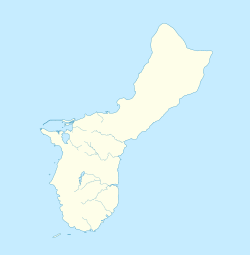San Vitores Martyrdom Site | |
 | |
| Location | 0.7 miles south of Bijia Point off Rte. 4, Tamuning, Guam |
|---|---|
| Coordinates | 13°30′59″N144°48′21″E / 13.51639°N 144.80583°E |
| NRHP reference No. | 75002154 [1] |
| Added to NRHP | October 31, 1975 |
The San Vitores Martyrdom Site, located 0.7 miles south of Bijia Point off Guam Highway 4 in Tamuning, Guam, has significance from 1672.[ citation needed ][ clarification needed ] It was listed on the National Register of Historic Places in 1975. [1]
It is an important site in marking where Father Diego Luis de San Vitores was killed, and for association with the Spanish-Chamorro Wars against the imposition of Catholic Christianity in Guam. At the time of NRHP listing, the site was marked by a wooden cross and by a historical plaque placed there in 1940. [2]

